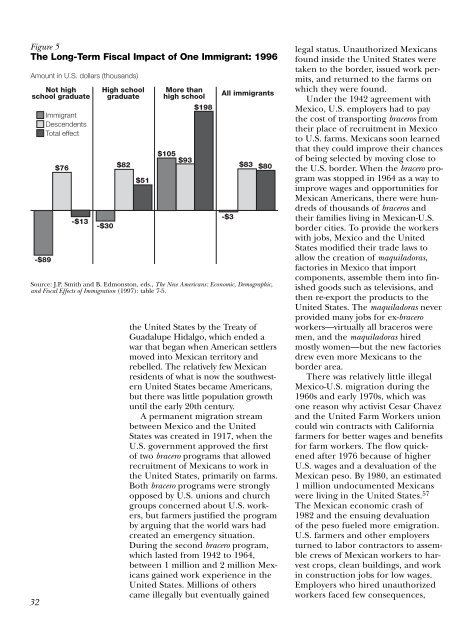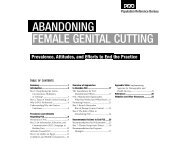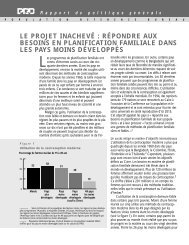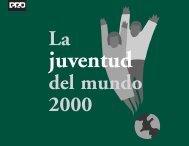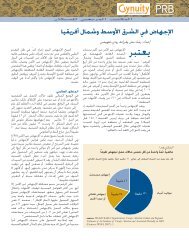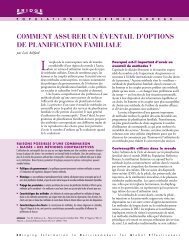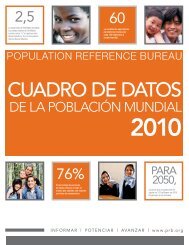Immigration Shaping America - Population Reference Bureau
Immigration Shaping America - Population Reference Bureau
Immigration Shaping America - Population Reference Bureau
You also want an ePaper? Increase the reach of your titles
YUMPU automatically turns print PDFs into web optimized ePapers that Google loves.
Figure 5<br />
The Long-Term Fiscal Impact of One Immigrant: 1996<br />
Amount in U.S. dollars (thousands)<br />
Not high<br />
school graduate<br />
32<br />
-$89<br />
Immigrant<br />
Descendents<br />
Total effect<br />
$76<br />
High school<br />
graduate<br />
-$13 -$30<br />
$82<br />
$51<br />
More than<br />
high school<br />
$105<br />
$93<br />
$198<br />
All immigrants<br />
-$3<br />
$83 $80<br />
Source: J.P. Smith and B. Edmonston, eds., The New <strong>America</strong>ns: Economic, Demographic,<br />
and Fiscal Effects of <strong>Immigration</strong> (1997): table 7-5.<br />
the United States by the Treaty of<br />
Guadalupe Hidalgo, which ended a<br />
war that began when <strong>America</strong>n settlers<br />
moved into Mexican territory and<br />
rebelled. The relatively few Mexican<br />
residents of what is now the southwestern<br />
United States became <strong>America</strong>ns,<br />
but there was little population growth<br />
until the early 20th century.<br />
A permanent migration stream<br />
between Mexico and the United<br />
States was created in 1917, when the<br />
U.S. government approved the first<br />
of two bracero programs that allowed<br />
recruitment of Mexicans to work in<br />
the United States, primarily on farms.<br />
Both bracero programs were strongly<br />
opposed by U.S. unions and church<br />
groups concerned about U.S. workers,<br />
but farmers justified the program<br />
by arguing that the world wars had<br />
created an emergency situation.<br />
During the second bracero program,<br />
which lasted from 1942 to 1964,<br />
between 1 million and 2 million Mexicans<br />
gained work experience in the<br />
United States. Millions of others<br />
came illegally but eventually gained<br />
legal status. Unauthorized Mexicans<br />
found inside the United States were<br />
taken to the border, issued work permits,<br />
and returned to the farms on<br />
which they were found.<br />
Under the 1942 agreement with<br />
Mexico, U.S. employers had to pay<br />
the cost of transporting braceros from<br />
their place of recruitment in Mexico<br />
to U.S. farms. Mexicans soon learned<br />
that they could improve their chances<br />
of being selected by moving close to<br />
the U.S. border. When the bracero program<br />
was stopped in 1964 as a way to<br />
improve wages and opportunities for<br />
Mexican <strong>America</strong>ns, there were hundreds<br />
of thousands of braceros and<br />
their families living in Mexican-U.S.<br />
border cities. To provide the workers<br />
with jobs, Mexico and the United<br />
States modified their trade laws to<br />
allow the creation of maquiladoras,<br />
factories in Mexico that import<br />
components, assemble them into finished<br />
goods such as televisions, and<br />
then re-export the products to the<br />
United States. The maquiladoras never<br />
provided many jobs for ex-bracero<br />
workers—virtually all braceros were<br />
men, and the maquiladoras hired<br />
mostly women—but the new factories<br />
drew even more Mexicans to the<br />
border area.<br />
There was relatively little illegal<br />
Mexico-U.S. migration during the<br />
1960s and early 1970s, which was<br />
one reason why activist Cesar Chavez<br />
and the United Farm Workers union<br />
could win contracts with California<br />
farmers for better wages and benefits<br />
for farm workers. The flow quickened<br />
after 1976 because of higher<br />
U.S. wages and a devaluation of the<br />
Mexican peso. By 1980, an estimated<br />
1 million undocumented Mexicans<br />
were living in the United States. 57<br />
The Mexican economic crash of<br />
1982 and the ensuing devaluation<br />
of the peso fueled more emigration.<br />
U.S. farmers and other employers<br />
turned to labor contractors to assemble<br />
crews of Mexican workers to harvest<br />
crops, clean buildings, and work<br />
in construction jobs for low wages.<br />
Employers who hired unauthorized<br />
workers faced few consequences,


